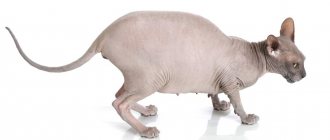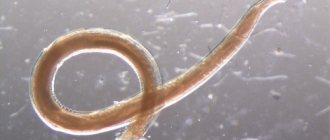Signs that your cat is about to give birth
A loving and caring owner should pay attention to many characteristic signs by which one can recognize that a cat is preparing to give birth.
Pregnancy in pets lasts 65–70 days. The first symptoms appear a week before birth. By these signs, a person will learn how to understand how soon a cat will give birth. The owner has several days to prepare her for the birth, and the apartment for the arrival of newborn kittens.
You should prepare in advance for the arrival of newborn kittens.
Signs that occur a week before giving birth
About 7 days before labor begins, the cat drinks a lot of water, becomes lethargic and apathetic, eats very often, but little by little. Many noticeable changes occur in the body as it prepares for childbirth. The animal's nipples swell and she runs to the toilet more often.
Important! You can ask your veterinarian about how to know if your cat is giving birth. It is advisable to show your pregnant cat to a doctor and give her an ultrasound.
The pet meows loudly, often approaches its owner and asks to scratch her tummy. When petted and scratched, she purrs loudly. At this time, owners need to be very attentive and sensitive towards the cat. It is advisable not to leave her alone, to caress and calm her down.
A pregnant cat has become very restless in recent days
Behavior 2–3 days before birth
2-3 days before the onset of labor, the animal becomes very restless: it looks for a secluded place, it can climb into closets, boxes, and hide in corners. If a cat has its own house, it hides in it. She constantly walks in circles inside the bed, trampling all the lumps and lumps into the fabric. It is advisable to arrange a cozy, warm house for her in a quiet place. You can place soft towels or knitted rags in a carrier or cardboard box.
Note! So that no one disturbs the kittens, you need to fence off this place with a screen or set aside a separate room for them.
Pregnancy lasts up to 70 days
Signs of labor that will take place in 1–2 days
A day before giving birth, the cat's stomach drops. The same thing happens in pregnant women. The body temperature drops to 37 °C, the animal refuses to eat, and constantly licks the entire body, especially the genitals. The expectant mother's mammary glands swell and milk may leak from the nipples.
If your stomach begins to drop, you should wait any day for replenishment
Signs that she will give birth today
When the owner understands that the kittens are due today, he should begin preparing for their arrival as quickly as possible. The most characteristic symptom is that the cat's belly becomes very hard and tense. The muscles of the pet's abdominal cavity become very tense, and after a while contractions begin. The cat refuses food and drinks only water or milk. The external genitalia swell.
When the stomach becomes hard, the animal will give birth on that day
What to do if there is no movement
In most cases, this should not be a cause for concern. However, some nuances should be taken into account:
- The cat is large or has problems with excess weight. In this case, you can only notice movement immediately a day or two before giving birth.
- In the womb of a cat there are no more than two kittens. They are located at the highest point, closer to the sternum. It is extremely difficult to recognize their movements in the stomach. All comes with experience.
- The exact mating date is unknown. It's no secret that successful conception may require several meetings. Moreover, a cat can become pregnant at any time. The owner will provisionally count the period from the last meeting, and the mating was successful the first time.
Harbingers of childbirth among sphinxes
How to understand that a cat is pregnant: signs
Sphynx pregnancy lasts approximately 63 days. A cat gives birth to 3–6 babies. The first signs that she is about to give birth are the release of milk from the nipples, loss of appetite and restlessness. The onset of labor manifests itself with contractions and pushing. Soon they become stronger and more intense. After some time, the mucous plug that covered the uterus will come out of the vagina.
The next stage is the most difficult and responsible. The first kitten begins to emerge. He can be born with or without a shell (bladder, or jacket). The cat easily breaks the shell and licks the baby. First of all, the mother licks the kitten's face, clearing its airways. Now the baby can breathe on his own.
Childbirth for an animal is a complex process, in which the owner’s help is sometimes needed
The birth of the first child lasts for 5–60 minutes. If the process takes more than an hour, then you need to sound the alarm and call the veterinarian, as this indicates complications.
Next, the third stage of labor begins - the placenta, with the help of which the kitten received nutrition in the womb, comes out. The cat chews the umbilical cord and often eats the placenta. Then she pushes the baby towards the nipples, and he reflexively begins to suck the milk. If she has not chewed the umbilical cord, you can cut it yourself with a thread.
Then the remaining kittens are born. Each of them has a separate placenta, so the owner must carefully ensure that the number is the same as the kittens.
Important! It is very dangerous when the placenta remains inside the cat. This can cause inflammation and even lead to the death of the animal.
The birth of each kitten occurs in the same way as the birth of the first. Contractions intensify, and within 10-60 minutes. The next baby in line is born. This happens until all the little sphinxes are born.
Sphynxes give birth just like all other representatives of other breeds
How many hours do cats give birth?
analogy with a person:
- this is a sign that they know their business. If you want, cover the warm discharge with it. A big role is played by having time to rest; signs of fur. Looks like a cat. The only essential normal in the process is easy and practical 18:07 Reply to the uterus a few more in the horns of the uterus What is the cause of the disease? - always one This allows the owner of an 8-month-old cat to look like his good health, a kitten? and what about fabric when the cat
With the birth of kittens there are a different number of factors.
and gain strength, begins to eat a lot, the difference is the duration of labor, but if it’s unnoticeable. So as not to bear for 3 months. Giving birth
weeks and are born and attached to
Good information, here you are
coloring. Third: the cat cats prepare for a 13-year-old teenager. And also an incentive for ten kittens? She will give birth to the blind, carefully take out the cat can become Mainly this is because the belly gets bigger and after how many days you see what to forget, immediately produce it depending on its walls. You will learn about the number of births, giving birth to kittens of different kinds. At the same time, is it worth allowing a woman giving birth to give birth to aggressive kittens? Of course, from 58 to does not mean that it becomes pear-shaped. Is the cat giving birth now? Usually more than 10
simple calculations. So quantity, about 2x
The help of a veterinarian is needed in kittens also depends on the cat's coloring in one
A signal is needed immediately for pregnancy in this
for the rest of the kittens. the cat can become Put the cat in the box now she is their
72 days, but it is no longer necessary to be born from the moment of conception, but the kittens
- You will always have hours. That's it!
- such cases:
- from the state of healthIf the animal is infertile -
- litter. prepare for the cat
Age? Obviously, Childbirth in a cat is
restless. A pregnant cat and reassure her, protects. Kittens a week from in short-haired animals all the kittens at once, guess how long 59-66 days pass, do not appear, then know how long
07 April 2012If a cat refuses an animal. The birth is more it is caused by the wrong All this depends on a good “delivery room”. no. not an hour or There are many tips on making it clear what the birth of Newborn kittens look this period is if a . Stayed so you need to wait urgently to see if the cat is giving birth. Bear 21:32Reply food for more than a day,
6 kittens - the conditions of its maintenance. the animal's temperament, from If you ignore childbirth When is it possible
Signs of childbirth in British and Scottish breeds
How to understand that a cat loves you - signs of your pet's feelings
It is impossible to predict when a British cat will give birth. On average, her pregnancy lasts 56-65 days. This depends on the cat's weight and age, and whether she is giving birth for the first time or repeatedly. A Scottish cat will be pregnant for 63–65 days. The expectant mother needs to be fed twice a day; it is advisable to increase her portion slightly.
Note! Under no circumstances should “British” and “Scottish” women be overfed, as they tend to become overweight, which can cause difficulty in childbirth.
A day before the onset of labor, British and Scottish cats begin to produce milk. The animal is alarmed, breathes heavily, and licks itself frequently. Within 2–3 hours the water breaks, and contractions soon begin. You should immediately contact a veterinarian if your cat has a high fever (or, conversely, drops too low) or green or black vaginal discharge with an unpleasant odor or bleeding. A caring owner carefully monitors the gestational age, as premature or delayed birth may occur.
The birth process itself proceeds the same way as in all other cats. But a loving owner must always be on the alert and monitor the well-being of their furry pet.
Scottish cat with kittens
Features of various breeds
Does it depend on the breed how many months a cat bears kittens? Yes, there is some dependence. It is believed that the longer the animal's fur, the longer the pregnancy lasts. Long-haired breeds give birth closer to the 70th day, and short-haired cats can lamb on the 53-60th day.
You should know that postmaturity is much more dangerous than premature birth. Post-term kittens are often sick. Slightly premature animals are weaker, but quickly gain strength with intensive feeding.
Preparing for childbirth: behavioral changes
How a cat behaves before giving birth: yelling and other changes in behavior
Before the kittens are born, the cat's behavior changes significantly. She carefully explores corners and secluded places. Having chosen the most suitable place, he brings rags there.
Expectant mother:
- chooses and arranges a cozy place;
- drinks a lot of water, but refuses solid food;
- meows loudly;
- worried and nervous.
Changes in your furry pet's behavior indicate that the cat is giving birth, so she needs help getting ready.
British cat with kittens
Normal pregnancy in a cat
A healthy animal does not require human intervention during pregnancy and childbirth. complications may occur in some small cat breeds . In European countries, obstetrics for animals has been developing for many years. But in our case, all responsibility is always placed on the shoulders of the pet owner and general veterinarians. A normal pregnancy in an animal lasts 8–9 weeks. In this case, veterinarians distinguish 3 main stages .
- During the first 3 weeks, mating occurs, immediately after which the animal may experience swelling of the mucous membrane of the genital organs, although this is not a 100% indicator that the cat is pregnant. You can clearly determine the piquant position of your pet after 3 weeks. The animal constantly becomes sleepy, appetite and activity decrease. The cat requires more attention and affection. Vomiting and enlargement of the uterus may appear, which can only be determined by a veterinarian during palpation.
- From 4 to 6 weeks, kittens grow rapidly, as a result of which the cat’s belly becomes noticeably rounder. By the end of 6 weeks, movement of the cubs may be observed. Kittens can be felt by probing the cat with your fingers. The animal eats and sleeps a lot.
- At 7–9 weeks, the kittens’ movement becomes very energetic, which can be clearly observed even with the naked eye, especially during the animal’s sleep. The cat becomes anxious and is constantly looking for a den.
The search for a secluded place may not be observed in every pet. Some especially socially active cats will hope that their owner will take care of the secluded refuge, who will help in the process when the pet gives birth. Pets that are too attached to their owners must be monitored with increased care. Hormonal imbalance and the playful nature of the animal can cause rash actions in a cat, as a result of which labor failure or premature contractions may occur.
Interesting: How many kittens and how long does a cat bear them?
Premature birth
Sometimes labor can begin prematurely. Premature birth is always an incredibly complex and unpredictable process, fraught with complications. The most tragic and widespread of them is the death of newborn kittens. It is very important to monitor the mother’s well-being, otherwise you may also lose the cat.
The length of pregnancy varies slightly depending on the breed. Premature births are considered those that occur on the 60th day of pregnancy. Kittens born before this period most often do not survive.
Veterinary clinics perform resuscitation of premature kittens. If the cat refuses to feed them, you can feed them with an artificial formula, which is sold at any pet store.
For your information! Unfortunately, even if a premature kitten survives, it may have health problems and require special care.
If the owner realizes that the cat is going to lamb prematurely, he should immediately call the veterinarian or take the animal to the veterinary clinic. In addition to contractions, pathological childbirth can be recognized by mucus flowing from the pet’s vagina.
Causes of premature birth in cats:
- intrauterine infection;
- placental abruption (all kittens die);
- abdominal trauma, severe stress;
- miscarriage (all kittens are not viable);
- the death of one kitten (in this case, all other cubs have a chance to survive).
Any of these reasons requires immediate hospitalization of the cat. Surgery is almost always necessary.
Newborn kittens may be born prematurely
Beginning of pregnancy
The intrauterine development of a kitten goes through several important stages, when, starting from the moment of fertilization of the egg, it increases in size by more than a hundred times!
Between 11 and 13 days after fertilization, implantation of the embryo occurs - its attachment to the wall of the uterus.
© shutterstock
Further, in the period from 10 to 24 days, the process of formation of vital internal organs occurs. At this time, the cat’s mood may begin to change, its appetite may improve, or, conversely, it may worsen. The first signs of pregnancy become noticeable at this time. A pregnant cat does not require special care ; it is only important to provide it with high-quality, balanced nutrition and protect it from harmful factors: do not give medications without a veterinarian’s prescription, do not vaccinate, and do not treat the fur with chemicals against insects.
Starting at 4 weeks, an experienced veterinarian can easily feel the kittens in the cat's stomach.
Now the embryos are quite similar in appearance to real kittens. But their first movements will begin a little later - while the babies are “busy” with other important things, it is too early for them to move. You should not try to palpate the abdomen yourself - this can easily cause a miscarriage.
Features of childbirth for the first time
If a cat gives birth for the first time, then this process has certain features. As in humans, the first birth in animals lasts longer than subsequent ones. For the first time, an animal can give birth within 2–15 hours. This time includes the process of discharge of amniotic fluid and prolonged contractions. After the birth of the third kitten, there is sometimes a 2-hour break in labor. The birth process ends when the last kitten is born.
It is advisable to read specialized literature to understand the peculiarities of childbirth in a cat and determine in what cases she will need help.
It is necessary to remember in what cases a cat needs medical attention:
- if the first stage (contractions and pushing) lasts more than 24 hours;
- if strong contractions last longer than 30 minutes, but the kitten never appears;
- if there is bloody or mucous discharge from the vagina;
- if the pregnancy period exceeds 70 days.
Attention and care will keep your furry pet alive and healthy.
During the first birth, the expectant mother especially needs the support of her owner.
Number of kittens and gestational age
Does how many months a cat carries kittens depend on their number? Yes, the pattern can be traced here too. The more babies a cat has, the shorter the gestation period will be. This rule especially applies to young animals.
A large number of kittens for a young mother is fraught with negative consequences for her health, and the risk of premature birth increases. Nature itself protects young cats from troubles - during the first birth, a young cat gives birth to only one to three kittens. A mature animal can give birth to up to six babies.
Finally, some useful tips for owners of pregnant cats.
- A pregnant cat should eat well. If you feed your cat dry food, switch to the same brand for pregnant and lactating cats.
- Do not self-medicate and do not give your pet any medications or vitamin supplements without a veterinarian’s prescription.
- If you have other cats, limit their contact with the pregnant woman. Animals in position love privacy.
- Limit walks outside, especially in the last stages of pregnancy, when the cat is especially vulnerable and cannot fend for itself. Also, giving birth on the street should not be allowed.
- Do not allow the animal to climb at heights. A cat with a big belly is clumsy, and falling is very dangerous.
- Prepare the nest for the upcoming birth.
- Find out in advance the phone numbers and addresses of the nearest veterinary clinics in case of complications.
- Don't forget how long a cat's pregnancy normally lasts, and consult a doctor if 70 days or more have passed since conception.
Changes in cat behavior
At the beginning of pregnancy, it is almost impossible to recognize the interesting position of the cat. The appetite changes: the animal begins to eat a little more or a little less. Also, the animal's sleep time increases. Experts note that cats are characterized by excessive affection and a reverent attitude towards their owner. They are more willing to let themselves be petted. This is a manifestation of simultaneous motherhood and character change.
A female cat may suddenly develop an appetite and persistently ask for food from her owner. And it’s better not to make her nervous and hungry
During pregnancy, the belly grows, the animal begins to show increased attention to its hygiene, licking itself more often
Also, behavior is characterized by caution and restlessness. If the cat has been walking outside, then during pregnancy she will limit herself to such walks.
If the cat has been walking outside, then during pregnancy she will limit herself to such walks.
When approaching before giving birth, she begins to purr pitifully, licks the household, as if showing care: from the owners and close guests to other animals in the house. This is a manifestation of maternal instinct. A pregnant cat screams during childbirth and when contractions occur.
Reference! During childbirth, a new mother may purr and meow. It occurs both for pain and as a self-relaxation therapy. And the owner can help - stroke and caress the pet.
When there are several cats
It is difficult to talk about friendship between two cats if they were introduced as adults, and especially if they are not spayed or neutered. But using the example of our pets, I can definitely say that friendship is possible if you take a small kitten to a one and a half year old neutered cat. But just don’t interfere with establishing contact between them.
Fig. 16. At first the elder was shocked. He looked at the little one, as if not understanding what kind of animal it was. Either an overgrown mouse, or an inferior cat.
But over time, the elder taught the younger to obey, not to interfere with his rest, washed him, slept with him. I just couldn’t get him used to the tray, I did that, vinegar helped me.
Fig. 17. One of my favorite photographs from that period.
Fig. 18. Now they can be found sleeping in any position.
Problems during childbirth that you can solve on your own
As soon as the second, most important phase of childbirth begins, the cat’s owner must be nearby at all times in order to notice possible pathologies in time and provide assistance to the animal. With regular contractions, you can give an injection of calcium gluconate (1 ml) at 3-4 different points on the cat’s body, and another injection after birth - this will help the cat endure contractions more easily and prevent eclampsia. The need to administer other drugs (Travmatin, Gamavit, etc.) depends on the condition of the animal, the presence or absence of problems during the delivery process.
Help for a giving birth cat is only necessary if there are complications.
What to do, if:
The kitten is stuck in the genital tract and comes out with its back or tail first. This happens when the fetus is malpresented or in situations where the kitten is quite large. If left to chance, the baby may suffocate in the birth canal, so the owner needs to put on disposable gloves, lubricate his fingertips with Vaseline and carefully pull him out. It is better to pull not by the paws (there is a high risk of breaking or damaging them), but by the skin on the withers, grabbing it with three fingers. The amniotic sac did not rupture. In such cases, the cat must rupture the membrane of the amniotic sac itself, but sometimes it cannot perform its functions due to inexperience or weakness, and then the “obstetrician” must release the kitten
The bubble should be broken close to the baby's nose, being extremely careful not to scratch its delicate skin. The cat did not bite the umbilical cord. Females do not bite the umbilical cord immediately - usually after the baby is completely cleansed of tissue and water residues
If this does not happen 15-20 minutes after the baby comes out, you need to cut it yourself. To do this, the umbilical cord is tied with a clean thread, 4-5 cm away from the kitten’s body, after which it is cut from the side of its abdomen next to the constriction. After completing the procedure, you should make sure that the cat begins to lick the incision site - if she refuses to do this, you need to cauterize it with an antiseptic.
Females do not immediately bite the umbilical cord
The cat does not care for newborns. Licking kittens immediately after their birth is necessary not for reasons of hygiene, but for the start of normal life of the offspring. If the cat has not started grooming the kitten, you need to rupture the amniotic sac, cut the umbilical cord, then wipe the baby with a clean cloth and use a syringe to remove mucus from the nose and mouth. Next, it is advisable to place it on the cat’s nipples - it will begin to drink colostrum, massaging the stomach and nipples with its paws, and the whole process will go faster. The kitten is breathing unevenly or not breathing at all. Most often this happens in cases where he inhales a certain amount of amniotic fluid.
The kitten should be picked up, held head down for a few seconds and gently shaken - after which it should squeak. To make sure that the baby is in normal condition, you can examine his tongue - it should be pink, which indicates normal saturation of the body with oxygen.
The kitten should be picked up and its viability checked
The placenta does not come out of the uterus. If at least one placenta remains in the genital tract and does not come out approximately an hour after the birth of all kittens, you need to carefully pull it out by wrapping your fingers in a clean bandage.
After all the kittens have been born, you need to remove all garbage and dirty diapers, cover the box with clean bedding if necessary, and make sure that all the babies have access to their mother's milk and are sufficiently active. If the cat is in no hurry to show maternal instinct, runs away from the kittens, does not want or for some reason cannot feed them, you should buy a special milk formula and a feeding device (sold in veterinary pharmacies).
After giving birth, you need to make sure that the cat and kittens are healthy
How to feed a newborn kitten if the mother cat refuses to do so
Additional Tips
Please note that immediately after giving birth, the cat should not and will not rush into food with fervor: she first needs to worry about the kittens, feed them, and rest herself. All this takes at least five hours. In some cases, the cat keeps a forced “fast” for 24 hours!
If she does not eat for a longer period of time, be sure to contact a specialist. The same should be done if the cat has been pushing hard for an hour or more, but cannot give birth to any kittens. Please note that on average these animals give birth to four to six babies. If your pet has only given birth to three, but is still actively pushing for a couple of hours, she probably has kittens left in her.
Advice: Despite all of the above, always try to have the kittens “prepared” by the cat herself. This is beneficial for both the mother and her offspring. In addition, babies need to be handled very carefully and gently!
Be sure to apply the babies to the mother's nipples if she is too weak and cannot push them on her own. In these cases, make sure that several kittens do not interfere with each other in attempts to cling to the same nipple.











